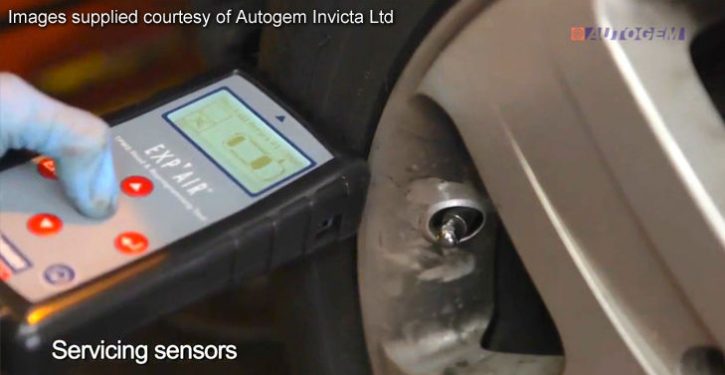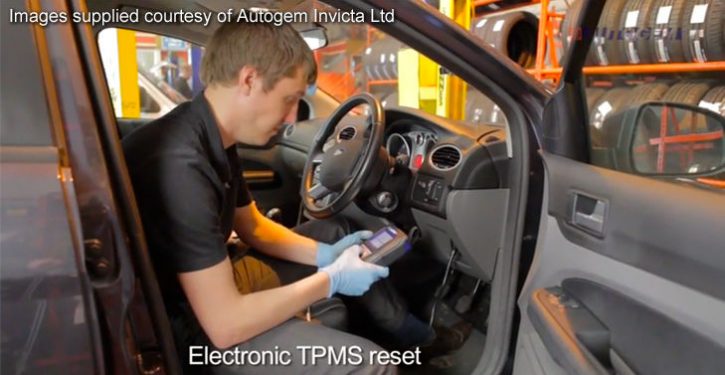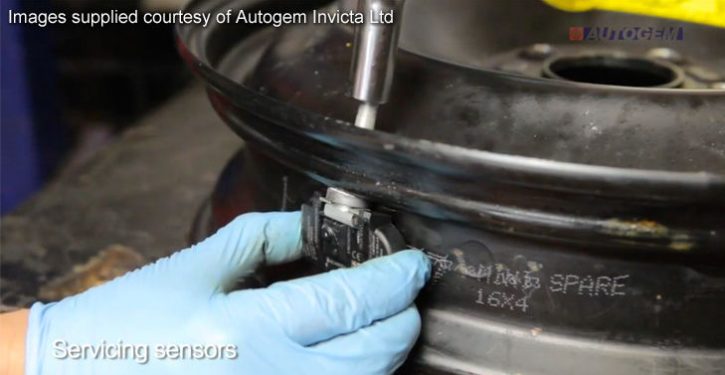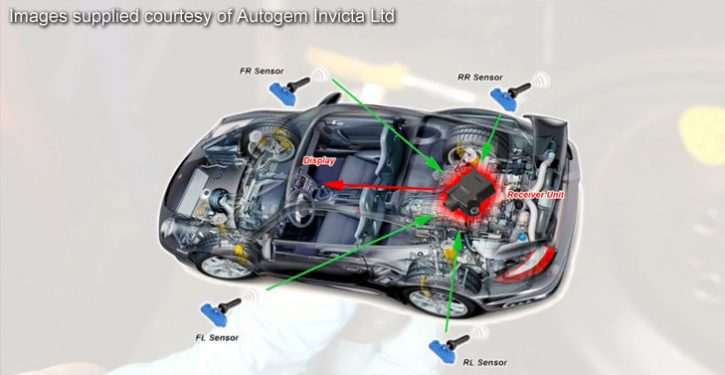
We are proud members of Point S, the worldwide leading independent tyre dealer network with over 5500 depots in 38 countries and over 18 million tyres sold per year! With this enormous buying power, we can offer our customers internet beating prices on budget and premium top brand tyres.
Tyre Pressure Monitoring System
We are a recognised TPMS Expert Centre, supported by the award-winning aftermarket supplier, Autogem. Correct and regular maintenance of the sensor is paramount in order for the system to be effective. Correct tyre pressures ensure optimal tyre life and fuel efficiency, as well as the many added safety benefits. Call us to find out more about TPMS. We keep vast stocks of TPMS stems and fitting kits for virtually all cars, we can also programme a new sensor to replicate any damaged TPMS sensors which have stopped working with our new technology i-sensor programming equipment.
What People Are Saying About Us
TPMS… somehow blew a valve on my car and rendered my tyre pressure monitor system useless...Read More
Stuart Bromley
Bought a set of alloys with winter tyres last October. I was concerned about the TPMS aspect fo...Read More
SteveJ
Thank you to Addison Tyre for professional and second to none service and providing the experti...Read More
PaulB
I have been using Addison Tyre for 15 years now and i never go anywhere else , why would I! [&h...Read More
AlexD
My first time at the garage and l shall use them again. Great service and welcoming staff....Read More
Elaine Morgan
Always go to Addison Tyre Tipton they are fab, even when people like me go in and ain’t g...Read More
Tracytlt
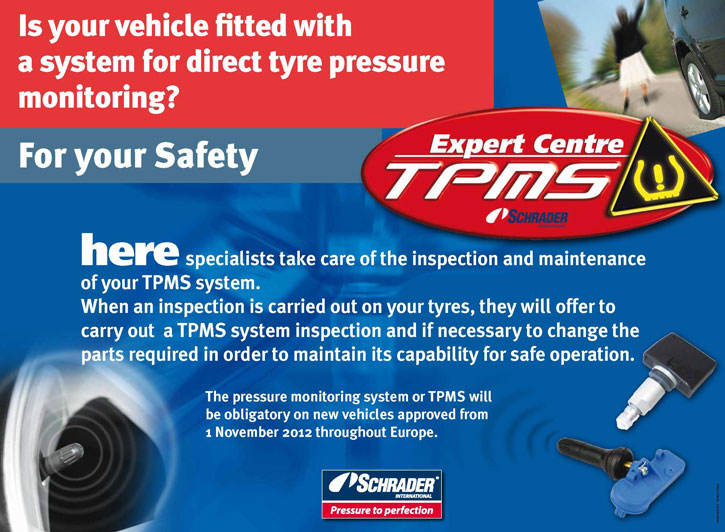
Frequently Asked Questions
Please find below a selection of FAQs. If you have any additional questions please do not hesitate to get in touch.
-
TPMS - What is it?
This is your Tyre Pressure Monitoring System. TPMS is now fitted to all new vehicles and is also part of the MOT. It is crucial to your safety to ensure the TPMS is working correctly at all times as it is proven that incorrect tyre pressure is the cause of thousands of accidents every year on our roads.
+ -
Why do my sensors need to be serviced?
It’s advisable to have your TPMS sensors serviced every 12 months or when you’re having a tyre replaced. Vehicle manufacturers recommend replacing the components that fasten the TPMS valve to your wheel. This is because of environmental weathering and corrosion which deteriorates the valve components. If these are not replaced your TPMS sensor could fail, therefore costing anything from £50 to well over £100. Servicing can cost as little as £10. There is an internal battery in the TPMS sensor which over time will run flat. The average life of the battery is between 3-7 years. If you have any questions regarding TPMS please don’t hesitate to give us a call.
+ -
When will my sensor need replacing?
The TPMS sensor has an internal battery which can last between 3-7 years dependant on use. Unfortunately, many valves need to be replaced prematurely due to lack of servicing or they are damaged when tyres are replaced.
+ -
Electronic Reset Charge - What Is It?
When a new TPMS valve is fitted, the new sensor needs to be paired to the ECU (engine control unit). This is to ensure that your sensors are recording and reporting the correct data from your tyres. Some TPMS sensors have to be electronically programmed by the tyre technician using electronic specialist equipment. We use the manufacturer approved Schrader system from Autogem. All work is fully guaranteed and always at very competitive prices.
+ -
How does the TPMS work?
There are currently two types of systems. The direct system, which continuously monitors the tyre pressure using valve sensors. The indirect system, which uses wheel speed and other vehicle sensors via ESP (traction control). The information from these sensors will illuminate a lamp on the dashboard warning the driver that the tyre pressure is below minimum requirements.
+ -
How does TPMS affect my safety?
Having TPMS fitted to all new vehicles will vastly reduce the number of vehicle accidents. Therefore reducing the number of serious injuries and crash fatalities which are caused by incorrectly inflated tyres. It is of the utmost importance to your safety to ensure your TPMS is working correctly at all times.
+ -
If the TPMS warning lamp illuminates what does this mean?
This means that the TPMS system has detected one or more of your tyres are below the recommended minimum tyre pressure. You should check all tyre pressures as soon as possible and inflate them to the correct pressure. The tyres should be inspected for possible puncture or defect, ideally at a TPMS approved tyre centre. When the tyres are properly inflated the warning lamp should then go off.
+ -
If the warning lamp goes on and off what does this mean?
This can happen in cold temperatures when the tyre pressure is only marginally below the warning limit. When the tyres heat up through driving or an increase in temperature, this may increase the tyre pressure to the accepted level then the light will go out. If the lamp continues to turn on and off then call into your nearest TPMS approved centre. The lamp should not be illuminated if the tyres are set to the correct tyre pressure.
+ -
If the warning lamp flashes on and off and then remains illuminated what does this mean?
This is indicating a malfunction. You will need to take the vehicle to a TPMS approved centre.
+ -
How can I identify the TPS warning lamp?
There are normally two different warning indicators for your TPMS warning lamp. One is an exclamation mark inside a cross section of a tyre. The other indicator is a picture of a car showing the tyre pressure on all four tyres.
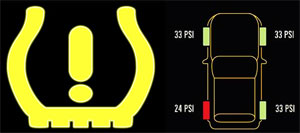 +
+ -
Correct tyre pressure - why is it important?
ROSPA, the safety experts, has estimated that 25% of vehicles on the roads in the UK are operated with under inflated tyre pressures. Vehicles which have tyres correctly inflated to the correct pressure have a more comfortable ride, braking distance is reduced, tyre life and fuel economy is drastically improved.
+ -
Can I tell if the tyre pressure is low by looking at the tyre?
If the tyre pressure is below the recommended level this is very difficult to tell visually. The only way to check the true pressure would be with an accurate pressure gauge. Always set tyre pressure to manufacturers specification.
+ -
Tyre pressure - why does it change?
Tyres can naturally lose 1-2 psi per month. The change in temperature can also make tyre pressure change. If you get a dramatic drop in tyre pressure you will most probably have a nail or screw which has punctured your tyre.
+ -
How does correct tyre inflation affect the environment?
If your vehicle has correctly inflated tyres it will use less fuel and also reduce the amount of carbon dioxide emitted. Tyre life will also be vastly improved. If all of the vehicles in the world were to use the correct tyre pressure this would have a dramatic effect on the environment.
+ -
Where can I find my correct tyre pressure for my car?
The correct tyre pressure should be located either on your fuel filler cap door or on the inside of the driver’s door panel. The correct tyre pressure can also be found in your vehicle owner’s manual. Do not inflate your tyres to the pressure indicated on the sidewall of your tyre as this will only show the maximum pressure for the tyre, not the recommended pressure. If you want any advice on correct tyre pressure, please call us we will let you know what the correct tyre pressure should be. We also offer a ‘free’ tyre pressure and tyre safety check.
+
LATEST NEWS
-
Claim up to £100 when you buy Michelin tyres at Addison Tyres!
Reserve your tyres on our home page https://www.discounttyre...
-
TOYO TYRES CLAIM BACK UP TO £30 AS SEEN ON TV
To enter, customers who buy Toyo tyres will need to reserve ...
-
Special Offers on New Point S Tyres, Premium Tyres Made by the one of the worlds leading tyre manufacturers.
MADE BY THE 3RD LARGEST TYRE MANUFACTURER IN THE WORLD! If y...
-
Keep your car safe in all weather conditions with Toyo Celsius All Season 2 tyres
Keep your car safe in all weather conditions with Toyo Celsi...
-
WE ARE RUNNING AN APPOINTMENT SERVICE SO PLEASE CALL US OR BOOK YOUR APPOINTMENT ONLINE
Please use Get A Quote form https://www.discounttyresuk.co....
-
LUCKY DAYS CAMPAIGN WITH MICHELIN TYRES CLAIM UP TO £100
HOW TO ENTER BUY 2 or 4 Michelin tyres from participating Po...
-
Dunlop Motorcycle Tyres £30 cash back promotion on selected pairs.
We are pleased to announce a retail cash back campaign comme...
-
BUY PIRELLI TYRES AND RECEIVE UP TO £60 LOVE2SHOP VOUCHERS AND CHANCE TO WIN £1000 HOLIDAY VOUCHERS!
SAVE MONEY WITH PIRELLI CAR TYRES OFFER ENDS 31ST JULY 2024 ...
-
Buy Michelin Motorcycle Tyres and claim back £30 in July and August!
This offer applies only to applicable Michelin tyres purchas...
-
WIN BACK THE COST OF YOUR TYRES THIS SUMMER!
WIN BACK THE COST OF YOUR TYRES THIS SUMMER! Promotion dates...
-
BUY TOYO TYRES IN JUNE AND CLAIM UP TO £30 AMAZON VOUCHERS!
BUY 2 TOYO TYRES 16″ AND ABOVE CLAIM £15 AMAZON VOUCH...



